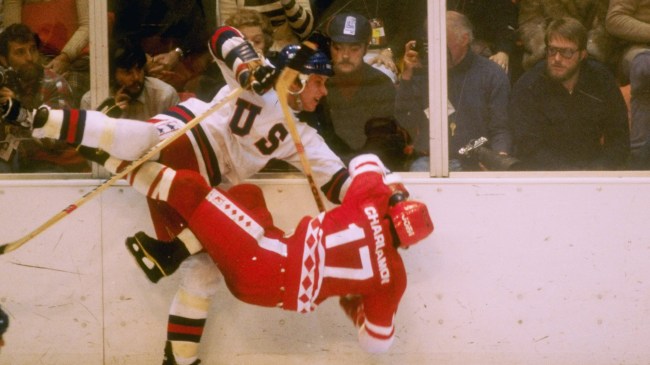in 
Getty Image
There aren’t many things sports fans love more than a good underdog, and history is filled with stories concerning athletes and teams who managed to overcome some truly overwhelming odds.
Plenty of those tales are tailormade for Hollywood, and the silver screen has been home to movies chronicling the unlikely path Rudy Ruettiger took to fulfill his unlikely dreams of playing football for Notre Dame and how Kurt Warner went from working in a grocery store to being inducted into the Football Hall of Fame.
In 2004, the ragtag group of hockey players that represented the United States at the 1980 Winter Olympics also got the movie treatment in the form of Miracle, which told the tale of what is arguably the most unlikely upset in the history of sports—the one appropriately dubbed the “Miracle on Ice.”
If you’ve seen that movie (or are just a fan of hockey history), you’re likely very familiar with the uphill battle Team USA was facing when they suited up to face off against an incredibly formidable Soviet Union squad in Lake Placid.
With that said, it’s still worth taking a closer look at just how unlikely their victory was on the 43rd anniversary of the day the ultimate underdog unfolded on the hockey rink.
Why Team USA had no business beating the Soviet Union in the Miracle on Ice

Getty Image
Canada was understandably the team to beat when ice hockey was first played at the Winter Olympics in 1920, and the teams repping the Great White North took home the gold medal on four consecutive occasions after the sport was introduced.
However, the Soviet Union eventually emerged as an international juggernaut. The country secured its first gold in Italy in 1956, and while the Americans were also able to take the top spot on the podium for the first time after winning on their home turf in 1960, their dominance was short-lived.
When the teams assembled in upstate New York in 1980, the Soviet Union was the overwhelming favorite to win its fifth consecutive gold medal when everything was said and done; after all, we’re talking about a team that hadn’t lost a single game in Olympic play since 1968 and seem poised to extend that impressive streak.
Part of the reason the Soviets had been as dominant as they were was the loophole they expertly exploited to gain an edge.
Professional hockey players weren’t allowed to participate in the Olympic games prior to 1986, so teams were forced to field a roster of amateurs. Players on the Soviet Union technically fell under that designation, but most of them were military officers in the Red Army whose primary duty was to be really, really good at hockey.
As a result, the Soviets had the luxury of developing some virtually unparalleled chemistry on the ice while harnessing the system perfected by Anatoli Tarasov, the visionary player and coach who studied chess and ballet while developing an approach that emphasized fast skating, quick passing, and puck possession that defined their style of play.
The United States, on the other hand, had historically relied on a more conservative approach.
Head coach Herb Brooks did opt to shake things up a bit after he was hired to helm Team USA ahead of the 1980 Olympics, but his focus on conditioning and a faster pace of play than most American players were accustomed to could only do so much to make up for the fact that he was working with a bunch of college hockey players who had an average age of 22 years old (for comparison, the average Soviet was closer to 26).
The United States failed to inspire much confidence prior to the start of the Winter Olympics, as they were absolutely embarrassed by the Soviets in their 10-3 loss at an exhibition game that was held at Madison Square Garden a few weeks before the tournament kicked off (even if you ignore that game, the Soviets still boasted a staggering 117-26 goal margin in the 12 games they’d played against the Americans prior to their showdown in Lake Placid).
It would be unfair to chalk up Team USA’s win to “puck luck,” but it’s hard to believe they were actually able to pull off the Miracle on Ice when you take a look at the stats concerning what unfolded over the course of the game.
According to ESPN, the Soviet Union was credited with 52 shots (as opposed to America’s 25) and was responsible for 74% of the scoring chances during even-strength play. However, Team USA’s defense stepped up when it mattered most and got some serious help from goaltender Jim Craig, who stood on his head to record 36 saves and successfully stop 92.3% of the shot he faced.
The Americans may have only had seven scoring chances, but they made the best of them by converting four times before Al Michaels uttered the most iconic line of his legendary broadcasting career.
So, yeah, it’s safe to say the Miracle on Ice was about as miraculous as it gets.
Related: Lucky Bettor Turns Free Bet Into $269K With Crazy Parlay Following Avalanche Stanley Cup Victory